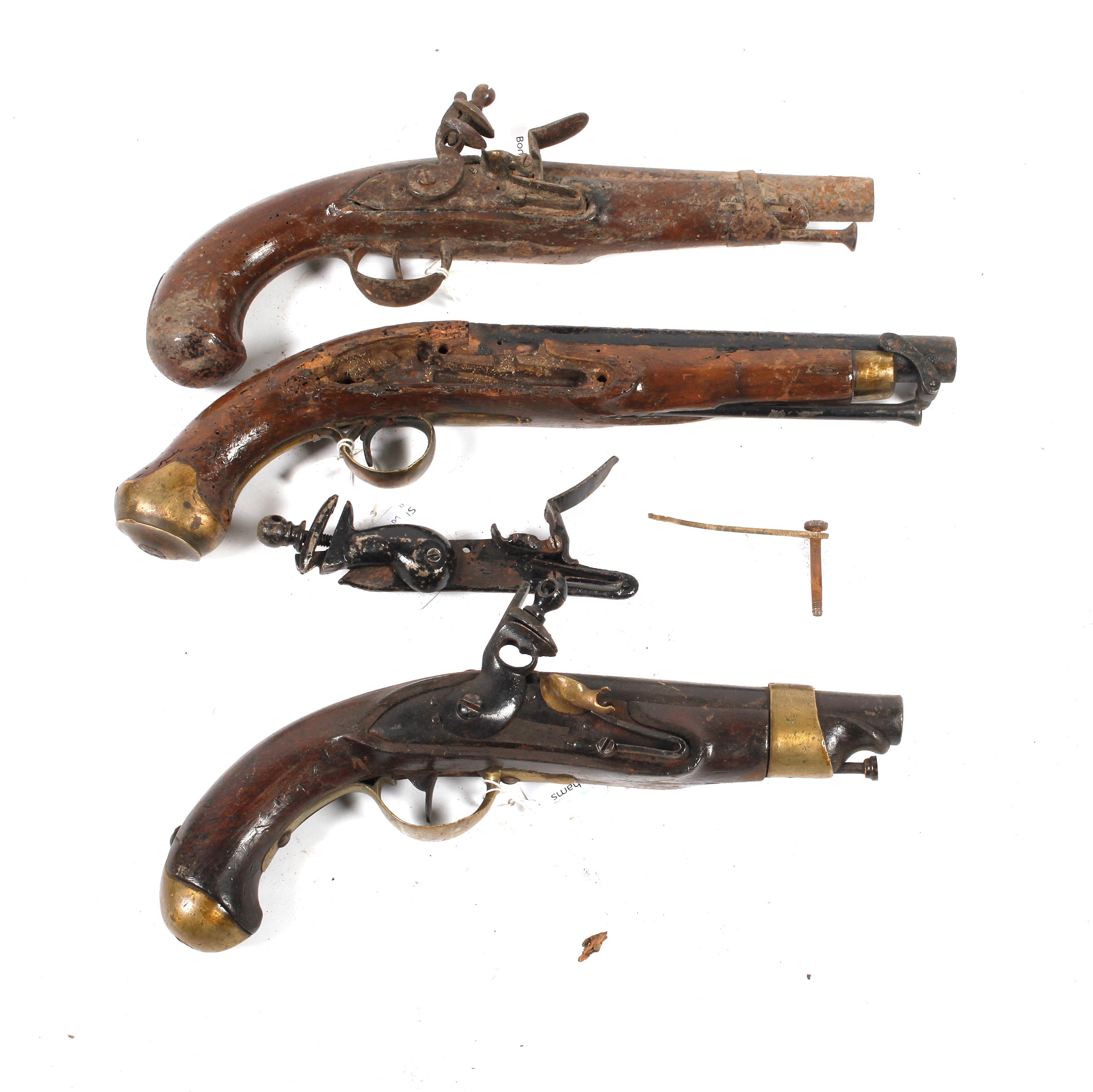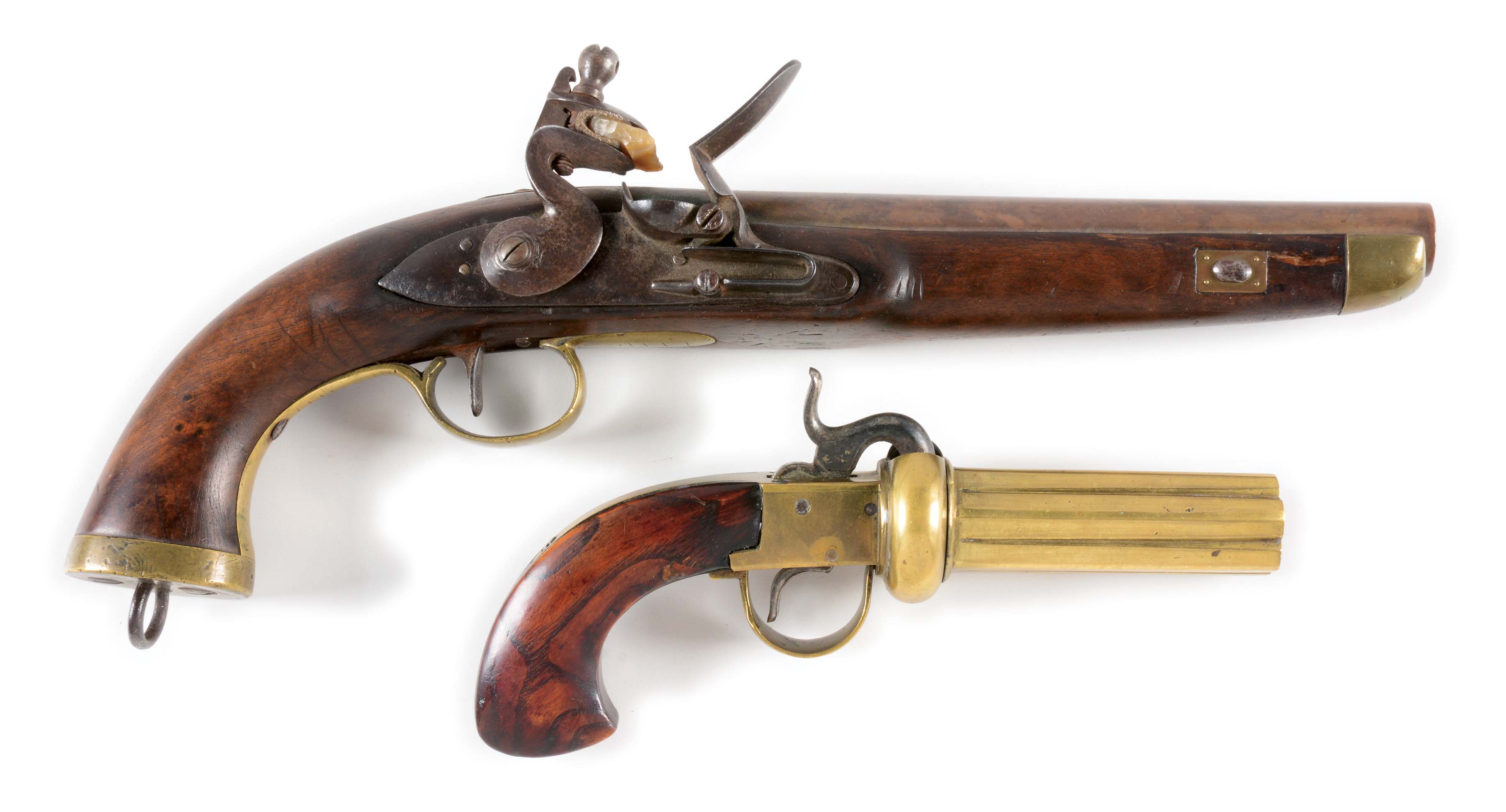A .600 FLINTLOCK SERVICE-PISTOL, SIGNATURE ERASED, MODEL 'SEA-SERVICE', no visible serial number, circa 1800, the barrel shortened by regulation to 9in., Tower proofs, solid top-tang, borderline engraved lock, the Tower signature erased from the tail and the GR crown device partially erased from in front of the hammer, walnut full-stock, carved apron around the top-tang, heavy brass furniture except iron belt hook and under-barrel ramrod, some shallow pitting and a small loss to wood below tail of lock Other Notes: This pistol was found with an old note stored inside the barrel (now framed and accompanying the lot) stating that this pistol was the property of Sir Ralph Abercrombie together with a line drawing of a blunderbuss and other indecipherable writing. It is unlikely to refer to this pistol as Sir Ralph Abercrombie died in 1801, before this pistol would probably have been modified, although the shortening of Sea Service pistols was not unheard of before this date and the pistol is in period with his career. Ralph Abercomby (often spelt 'Abercrombie') was the eldest son of George Abercromby of Tullibody, Clackmannanshire, and a brother of the advocate Alexander Abercromby, Lord Abercromby and General Sir Robert Abercromby. He was born at Menstrie Castle, Clackmannanshire. His mother was the clever and beautiful daughter of Mr. Dundas of Manor in Stirlingshire. Ralph Abercromby's education, begun by a private tutor, was continued at the school of Mr. Moir at Alloa, then considered one of the best in Scotland despite its Jacobite leanings. After passing some time here, Ralph was sent to Rugby, where he remained till he was eighteen, then becoming a student at the University of Edinburgh. In Edinburgh he studied moral and natural philosophy and civil law and was regarded by his professors as sound rather than brilliant. He was sent to Leipzig University in 1754 to study civil law with a view to career as an advocate. On returning from the continent, Abercromby expressed a strong preference for the military profession, and a cornet's commission was accordingly obtained for him (March 1756) in the 3rd Dragoon Guards. He served with his regiment in the Seven Years' War, and thus, the opportunity afforded him of studying the methods of Frederick the Great, who moulded his military character and formed his tactical ideas. He rose through the intermediate grades to the rank of Lieutenant-Colonel of the regiment (1773) and Brevet Colonel in 1780, then in 1781, he became Colonel of the King's Irish Infantry. When that regiment was disbanded in 1783, he retired upon half pay. He also entered Parliament as MP for Clackmannanshire (1774–1780). He was a strong supporter of the American cause in the American Revolutionary War, and remained in Ireland to avoid having to fight against the colonists. When France declared war against Great Britain in 1793, he resumed his duties. He was appointed command of a brigade under the Duke of York for service in the Netherlands, where he commanded the advanced guard in the action at Le Cateau. During the 1794 withdrawal to Holland, he commanded the allied forces in the action at Boxtel and was wounded directing operations at Fort St Andries on the Waal. In 1795, he was appointed a Knight of the Bath for his services. That same year, he was appointed to succeed Sir Charles Grey as commander-in-chief of the British forces in the West Indies. In 1796, Grenada was suddenly attacked and taken by a detachment of the army under his orders. Afterwards, Abercromby secured possession of the settlements of Demerara and Essequibo in South America, the islands of Saint Lucia, Saint Vincent and Trinidad. A major assault on the port of San Juan, Puerto Rico, in April 1797 ended in disaster after fierce fighting where both sides suffered heavy losses. Abercromby returned to Europe and, in reward for his services, was appointed Colonel of the 2nd (Royal North British) Regiment of Dragoons. He was also made Lieutenan
A .600 FLINTLOCK SERVICE-PISTOL, SIGNATURE ERASED, MODEL 'SEA-SERVICE', no visible serial number, circa 1800, the barrel shortened by regulation to 9in., Tower proofs, solid top-tang, borderline engraved lock, the Tower signature erased from the tail and the GR crown device partially erased from in front of the hammer, walnut full-stock, carved apron around the top-tang, heavy brass furniture except iron belt hook and under-barrel ramrod, some shallow pitting and a small loss to wood below tail of lock Other Notes: This pistol was found with an old note stored inside the barrel (now framed and accompanying the lot) stating that this pistol was the property of Sir Ralph Abercrombie together with a line drawing of a blunderbuss and other indecipherable writing. It is unlikely to refer to this pistol as Sir Ralph Abercrombie died in 1801, before this pistol would probably have been modified, although the shortening of Sea Service pistols was not unheard of before this date and the pistol is in period with his career. Ralph Abercomby (often spelt 'Abercrombie') was the eldest son of George Abercromby of Tullibody, Clackmannanshire, and a brother of the advocate Alexander Abercromby, Lord Abercromby and General Sir Robert Abercromby. He was born at Menstrie Castle, Clackmannanshire. His mother was the clever and beautiful daughter of Mr. Dundas of Manor in Stirlingshire. Ralph Abercromby's education, begun by a private tutor, was continued at the school of Mr. Moir at Alloa, then considered one of the best in Scotland despite its Jacobite leanings. After passing some time here, Ralph was sent to Rugby, where he remained till he was eighteen, then becoming a student at the University of Edinburgh. In Edinburgh he studied moral and natural philosophy and civil law and was regarded by his professors as sound rather than brilliant. He was sent to Leipzig University in 1754 to study civil law with a view to career as an advocate. On returning from the continent, Abercromby expressed a strong preference for the military profession, and a cornet's commission was accordingly obtained for him (March 1756) in the 3rd Dragoon Guards. He served with his regiment in the Seven Years' War, and thus, the opportunity afforded him of studying the methods of Frederick the Great, who moulded his military character and formed his tactical ideas. He rose through the intermediate grades to the rank of Lieutenant-Colonel of the regiment (1773) and Brevet Colonel in 1780, then in 1781, he became Colonel of the King's Irish Infantry. When that regiment was disbanded in 1783, he retired upon half pay. He also entered Parliament as MP for Clackmannanshire (1774–1780). He was a strong supporter of the American cause in the American Revolutionary War, and remained in Ireland to avoid having to fight against the colonists. When France declared war against Great Britain in 1793, he resumed his duties. He was appointed command of a brigade under the Duke of York for service in the Netherlands, where he commanded the advanced guard in the action at Le Cateau. During the 1794 withdrawal to Holland, he commanded the allied forces in the action at Boxtel and was wounded directing operations at Fort St Andries on the Waal. In 1795, he was appointed a Knight of the Bath for his services. That same year, he was appointed to succeed Sir Charles Grey as commander-in-chief of the British forces in the West Indies. In 1796, Grenada was suddenly attacked and taken by a detachment of the army under his orders. Afterwards, Abercromby secured possession of the settlements of Demerara and Essequibo in South America, the islands of Saint Lucia, Saint Vincent and Trinidad. A major assault on the port of San Juan, Puerto Rico, in April 1797 ended in disaster after fierce fighting where both sides suffered heavy losses. Abercromby returned to Europe and, in reward for his services, was appointed Colonel of the 2nd (Royal North British) Regiment of Dragoons. He was also made Lieutenan















Testen Sie LotSearch und seine Premium-Features 7 Tage - ohne Kosten!
Lassen Sie sich automatisch über neue Objekte in kommenden Auktionen benachrichtigen.
Suchauftrag anlegen